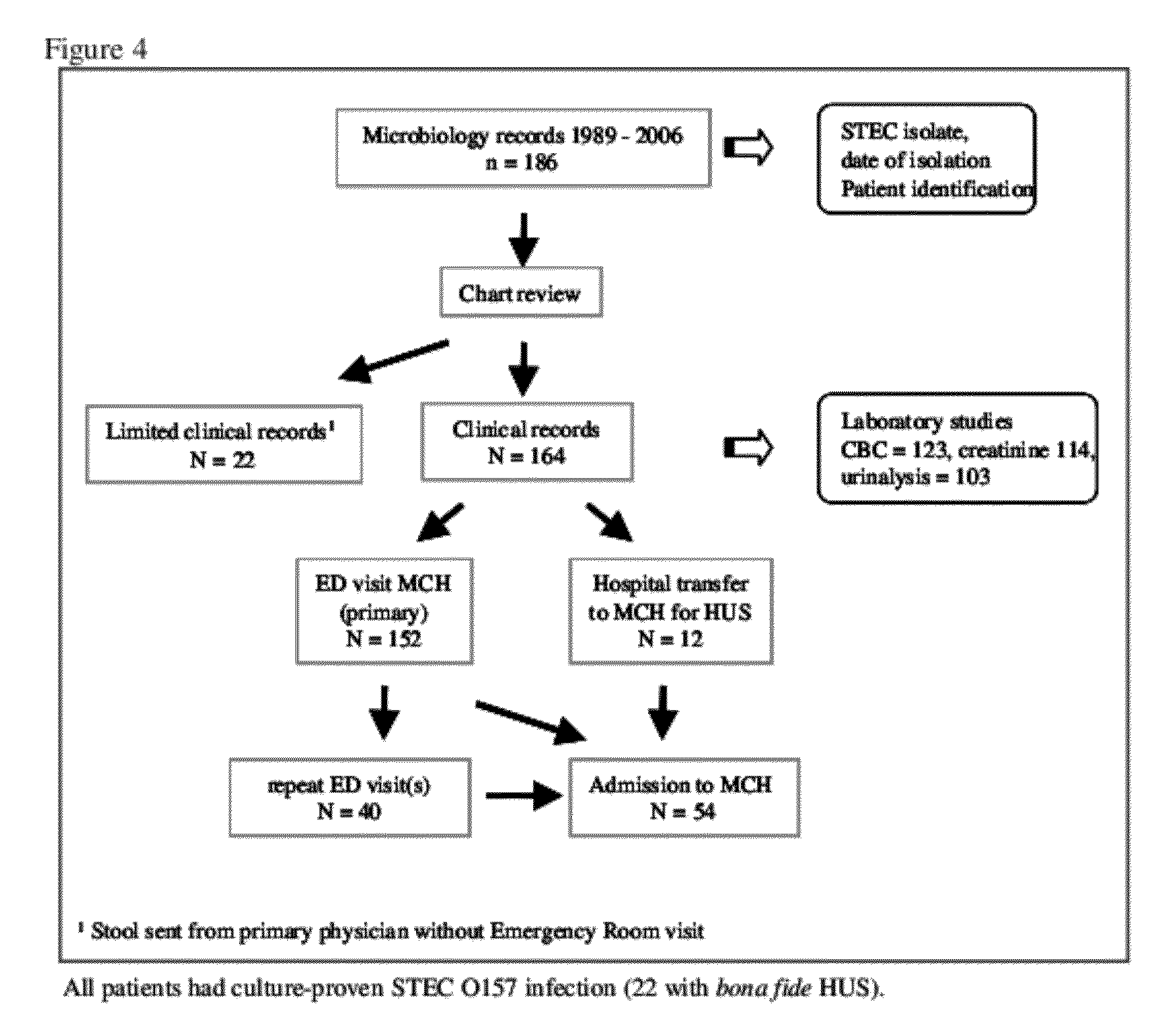Methods, compositions, and kits for treating shiga toxin associated conditions
a technology of toxin-associated conditions and compositions, applied in the direction of drug compositions, antibacterial agents, antibacterial ingredients, etc., can solve the problems of no known cure or vaccine for hus, and approximating a 5-10% fatality ra
- Summary
- Abstract
- Description
- Claims
- Application Information
AI Technical Summary
Benefits of technology
Problems solved by technology
Method used
Image
Examples
example 1
Safety and Tolerability of Chimeric Anti-Shiga Toxin 1 (cαStx1) and Shiga Toxin 2 (cαStx2) in Healthy Adults
Introduction
[0044]Currently there is no causal treatment for Shiga toxin producing bacterial (STPB) infection and its complications. Chimeric monoclonal antibodies against Shiga toxin 1 and Shiga toxin 2 (designated cαStx1 and cαStx2) have been developed to address this unmet medical need. Since human STPB can produce either or both Shiga toxins, antibodies against both toxins are needed to maximize chances for clinical success. In preclinical studies, neither of the two monoclonal antibodies was found to be associated with any systemic toxicity in two species.
[0045]The safety, tolerability and pharmacokinetics of the anti-toxins cαStx1 and cαStx2 in healthy adults from two Phase I studies are presented below.
Objective
[0046]The primary objective of two clinical Phase I studies, conducted in healthy male and female adults, was to evaluate the safety and tolerability of chimeric...
example 2
Toxicology and Immunogenicity of cαStx1 and cαStx2 in Mice and Marmosets
Introduction
[0066]Shiga toxin producing Escherichia coli (STEC) are zoonotic pathogens that cause potentially fatal and often epidemic and food or waterborne illness with a clinical spectrum that includes diarrhea, hemorrhagic colitis and hemolytic uremic syndrome (HUS)(Karmali M A, et al. J Infect Dis, 2003: 188 (1 December) 1724-1729). STEC produces two distinct Shiga toxin types, Shiga toxin 1 and Shiga toxin 2 (Karmali M A, et al. J Infect Dis, 2004: 189 (1 February) 355-359). Currently there is no specific treatment against STEC infection but two specific anti-toxins are in development to treat infections due to Shiga toxin producing bacteria (STPB).
[0067]The toxicology and immunogenicity of the anti-toxins tested in two animal species are presented in this example. The mouse was tested because it is a universally used model for evaluating the toxicity of various classes of chemicals and for which there is ...
example 3
Pharmacokinetics of cαStx1 and cαStx2 in Mice
Introduction
[0087]Shiga toxins 1 and 2 are the virulence factors that are responsible for the complications that come from infection by Shiga toxin producing bacteria (STPB) (Gavin P J, et al. J Clin Microbiology, April 2004, p. 1652-1656). Shiga toxin producing Escherichia coli (STEC) strains represent the most important recently emerged group of food-borne pathogens (Blanco J E, et al. J Clin Microbiology, January 2004, p. 311-319). STEC causes a potentially fatal foodborne illness whose clinical spectrum includes asymptomatic carriage, nonspecific diarrhea, bloody diarrhea, hemorrhagic colitis and hemolytic uremic syndrome (HUS) (Karmali M A, Molecular Biotechnology, Vol. 26, 2004, p. 117-122; Klein E J, et al. J Pediatr, August 2002, Vol 141, No. 2, p. 172-177). Two specific monoclonal antibodies against Shiga toxin 1 and 2 have been developed to treat STPB infection.
[0088]cαStx1 and cαStx2 are chimeric monoclonal IgG1 antibodies that...
PUM
| Property | Measurement | Unit |
|---|---|---|
| Time | aaaaa | aaaaa |
| Time | aaaaa | aaaaa |
| Time | aaaaa | aaaaa |
Abstract
Description
Claims
Application Information
 Login to View More
Login to View More - R&D
- Intellectual Property
- Life Sciences
- Materials
- Tech Scout
- Unparalleled Data Quality
- Higher Quality Content
- 60% Fewer Hallucinations
Browse by: Latest US Patents, China's latest patents, Technical Efficacy Thesaurus, Application Domain, Technology Topic, Popular Technical Reports.
© 2025 PatSnap. All rights reserved.Legal|Privacy policy|Modern Slavery Act Transparency Statement|Sitemap|About US| Contact US: help@patsnap.com



